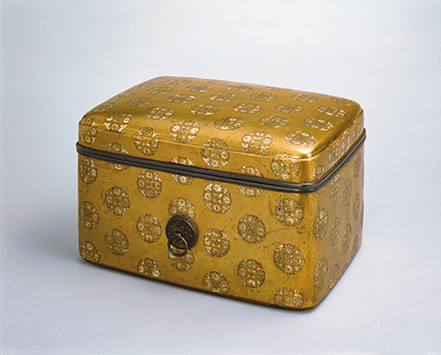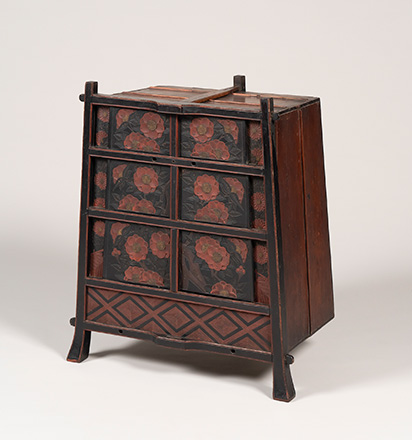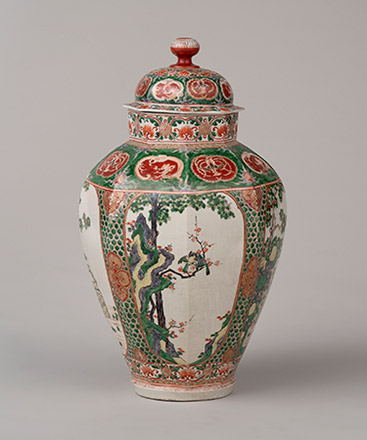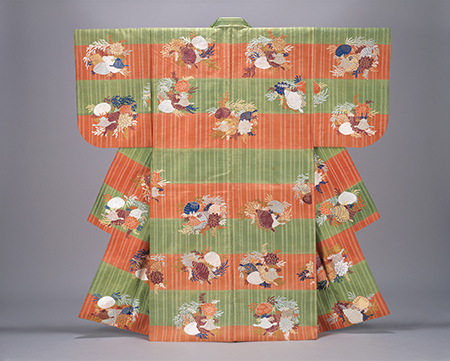- Calendar
- Online Ticket Sales
- Access
- JA
- EN
Paragon or Puzzle?
Your Own Perspectives on Works in the Suntory Museum of Art Collection
April 17 to June 16, 2024
*Download the list of changes in works on display
*There will be an exhibition change during the course of exhibition.
*Photography permitted only for works with PHOTO OK mark in this exhibition.
The list of changes in worksPDF
*The order of chapters may change at the exhibition venue.
Section 1
Lacquerware: Adoring Life with Beauty
Lacquerware is one of Japan's iconic traditional crafts. Furnishings and other everyday lacquerware items with delicately beautiful mother-of-pearl inlay and maki-e designs primarily adorned the lives of the elites. Those works that have been handed down to us include many regarded as paragons, marvels of incomparable refinement.
Over time, lacquerware also became part of commoner lives, adorning many household items. Most of those lacquerware pieces were for serving food and beverages and often had simple, plain forms. These utilitarian wares directly communicate people's lifestyles, their very lives, back then.
Because lacquerware items are familiar parts of life, regardless of the era or the owner’s status, they secretly keep within them a fascination beyond their mere decorative beauty.
The works introduced in this section from the Suntory Museum of Art's collection of lacquerware are bound to include items that you would like to have beside you and to use, marvels that are, to you, paragons.

1 set, Edo period, 18-19th century
Suntory Museum of Art 【To be shown over an entire period】

Kamakura period, 13th century
Suntory Museum of Art 【To be shown over an entire period】

Muromachi period, 16th century
Suntory Museum of Art 【To be shown over an entire period】
Section 2
Paintings: Loved Generously
The collection of paintings that the Suntory Museum of Art has built, in accord with our search for "Art in Life," consists primarily of the folding screens and hanging scrolls used to divide rooms and decorate tokonoma alcoves. It also includes picture scrolls that depict how people lived back when they were created. The dazzling folding screens with bird-and-flower paintings or genre paintings that decorated the homes of daimyō and aristocrats are spectacular. These paintings, packed with dynamism down to the smallest details, delight us with their vibrancy.
By contrast, the otogi-zōshi picture scrolls from the Muromachi period (1336-1573) depict short tales in a wide range of painting styles, from powerful, dramatic depictions to those with a simplicity that has nothing to do with technique. These picture scrolls have been loved, generation after generation, over the centuries, and handed down with care. These paintings suggest that "painted prettily, with great skill" is not a necessary condition for recognition as a paragon.
This section introduces a diverse group of Japanese paintings, from works that anyone would appreciate for their superb style to simple, naive works that speak directly to the viewer's heart. Forget about "skillful" and "clumsy"; if you open your heart to observe these works from a generous point of view, you may encounter a deeply meaningful marvel that is yours alone.

Left of four-panel folding screens, Momoyama period, 17th century
Suntory Museum of Art 【On display between Apr. 17 and May 13】

Right of four-panel folding screens, Momoyama period, 17th century
Suntory Museum of Art 【On display between Apr. 17 and May 13】

Set of 2 handscrolls, Muromachi period, 16th century
Suntory Museum of Art 【On display between May 15 and Jun. 16】
Section 3
Ceramics: Living with Humanity's Best Friend
Ceramics production began in Japan in the Jōmon period (13,000-400 BCE). Since then, while often strongly influenced by works from overseas, Japanese ceramics have developed in many ways, depending on the era and the region. In the Momoyama and Edo periods (1568-1868), creative works distinctive to Japan bloomed. Mino ware, with its bold designs; Imari, with its lovely underglaze cobalt and overglaze enamel decors; Nabeshima, the ultimate in sophistication; Kyoto ware, with its elegant grace: each has produced a multitude of works that can be positioned as paragons, their outstanding creative styles exemplifying Japanese ceramics.
As we consider the long history of ceramics in Japan, however, we must not forget that before they were treated as works of art, ceramics were necessities of life. For example, jars from the medieval period, which were increasingly appreciated in modern times, have the essence of beauty lodged in them, the changes they have undergone over time telling us that they have been passed down from generation to generation. Theirs is a beauty of form born in the course of everyday life.
This section presents a diverse group of ceramics from our collection, dating from the Nara through the Edo periods. As you decipher the history each of these works has lived through, don't be surprised to discover the unknown fascination of these marvels.

Arita, Edo period, 17-18th century
Suntory Museum of Art 【To be shown over an entire period】

Tamba, Northern and Southern Courts period, 14th century
Suntory Museum of Art 【To be shown over an entire period】
Section 4
Textiles and Ornaments: We've Just Got to Wear Them
Textile products and ornaments are the basic elements in the act of dressing, of adorning oneself appropriately for every phase of life. Our sense of beauty is expressed, condensed, in them.
For example, the kosode, the ancestral form of today's kimono, is a garment made with materials and motifs to suit the season and the formality of the occasion. Through kosode, we can glimpse what life was like in the past. Distinctive ways of decorating textiles, from Tsugaru koginzashi embroidery to Okinawan bingata stencil resist dyeing, draw our eyes to specific kinds of beauty rooted in each region's climate and culture.
Ornaments can be amazing. The decorative combs and ornamental hairpins of the Edo period developed their own astonishing miniature world of beauty. With their richly witty designs, they went far beyond the utility of combing the hair and fixing it in place. They were filled with the Edo passion for self-expression—a passion that lives on today—through styling one's body, dressing up. Some of these individual, innovative ornaments could not be worn stylishly by someone who lacked good taste.
Today, as in the past, the decisive factor in fashion is acting on one's preferences. As you explore these exhibits, why not search for the garments and accessories you would like to wear—and find your own marvels.

Edo period, 18-19th century
Suntory Museum of Art 【On display between Apr. 17 and May 13】

Edo period, 19th century
Suntory Museum of Art 【To be shown over an entire period】
Section 5
The Aesthetics of Tea: Decide with Clear Eyes
The tea ceremony has had a significant influence on Japanese lifestyles. It is an inextricable part of "Art in Life."
The tea ceremony we know today originated in Japan's medieval period. The basics are that one chooses utensils from ordinary vessels and other items, according to one's own taste, thoughtfully combines them for a single occasion, and serves the guests invited to the tea gathering. The culture of tea opened a path for nameless works with no provenance to become famous marvels, depending on who chose to use them. It also inspired the creation of a wide variety of utensils designed for the tea ceremony.
Vases and tea bowls in a vast range of styles, from works expressing the simple charm of the clay to splendid overglaze enamels, tea kettles incorporating delicate motifs and bold forms in their functionality, lacquerware works repurposed as incense containers: the tea utensils from the museum collection introduced in this section communicate the free, individualistic beauty inspired by the tea ceremony.
If you were to choose from these utensils for a tea gathering, which would you pick, and how would you combine them? Identifying the pieces you prefer is a search for your very own paragons and marvels.

Nonomura Ninsei, Edo period, 17th century
Suntory Museum of Art 【To be shown over an entire period】

Ashiya, Muromachi period, 15th century
Suntory Museum of Art 【To be shown over an entire period】
Section 6
Glass: Loving Transparency, Even
The Suntory Museum of Art's highly distinctive glass collection covers a broad range of production areas and periods. It includes highly individual works: Venetian glass, which influenced glass production throughout Europe; Japanese glass, which is based on techniques from China and Europe; Qing dynasty glass, whose opaque materiality fascinated Emile Gallé. These works express mutual interactions despite being from distant periods and regions. The result is the birth of paragons of sublime beauty, marvels created with a variety of sophisticated techniques, from a multitude of times and places.
Admiring these works, we must not forget that glass is also a familiar part of "Art in Life." The German stangenglas, a tall glass with many projections attached, the Spanish cantir, used for passing wine around and drinking it in turn, a somewhat ephemeral-seeming footed cup from Japan: a world of distinctive forms rooted in lifeways has unfolded.
This section introduces glass from many periods and regions, from gorgeous works made for royalty or nobility to vessels for which functionality was the priority. Learning about the lifestyles of each region, we can discover marvels that celebrate an appeal beyond transparency or fragility.

Emile Gallé, France, ca. 1900
Suntory Museum of Art 【To be shown over an entire period】

Japan, Edo period, 18th century
Suntory Museum of Art 【To be shown over an entire period】
*Unauthorized reproduction or use of texts or images from this site is prohibited.
2025 January
- Exhibition
- Closed
- Tea Ceremony
- Mon
- Tue
- Wed
- Thu
- Fri
- Sat
- Sun
- 1
- 2
- 3
- 4
- 5
- 6
- 7
- 8
- 9
- 10
- 11
- 12
- 13
- 14
- 15
- 16
- 17
- 18
- 19
- 20
- 21
- 22
- 23
- 24
- 25
- 26
- 27
- 28
- 29
- 30
- 31
2025 February
- Exhibition
- Closed
- Tea Ceremony
- Mon
- Tue
- Wed
- Thu
- Fri
- Sat
- Sun
- 1
- 2
- 3
- 4
- 5
- 6
- 7
- 8
- 9
- 10
- 11
- 12
- 13
- 14
- 15
- 16
- 17
- 18
- 19
- 20
- 21
- 22
- 23
- 24
- 25
- 26
- 27
- 28
2025 March
- Exhibition
- Closed
- Tea Ceremony
- Mon
- Tue
- Wed
- Thu
- Fri
- Sat
- Sun
- 1
- 2
- 3
- 4
- 5
- 6
- 7
- 8
- 9
- 10
- 11
- 12
- 13
- 14
- 15
- 16
- 17
- 18
- 19
- 20
- 21
- 22
- 23
- 24
- 25
- 26
- 27
- 28
- 29
- 30
- 31
2025 April
- Exhibition
- Closed
- Tea Ceremony
- Mon
- Tue
- Wed
- Thu
- Fri
- Sat
- Sun
- 1
- 2
- 3
- 4
- 5
- 6
- 7
- 8
- 9
- 10
- 11
- 12
- 13
- 14
- 15
- 16
- 17
- 18
- 19
- 20
- 21
- 22
- 23
- 24
- 25
- 26
- 27
- 28
- 29
- 30
2025 May
- Exhibition
- Closed
- Tea Ceremony
- Mon
- Tue
- Wed
- Thu
- Fri
- Sat
- Sun
- 1
- 2
- 3
- 4
- 5
- 6
- 7
- 8
- 9
- 10
- 11
- 12
- 13
- 14
- 15
- 16
- 17
- 18
- 19
- 20
- 21
- 22
- 23
- 24
- 25
- 26
- 27
- 28
- 29
- 30
- 31
2025 June
- Exhibition
- Closed
- Tea Ceremony
- Mon
- Tue
- Wed
- Thu
- Fri
- Sat
- Sun
- 1
- 2
- 3
- 4
- 5
- 6
- 7
- 8
- 9
- 10
- 11
- 12
- 13
- 14
- 15
- 16
- 17
- 18
- 19
- 20
- 21
- 22
- 23
- 24
- 25
- 26
- 27
- 28
- 29
- 30
2025 July
- Exhibition
- Closed
- Tea Ceremony
- Mon
- Tue
- Wed
- Thu
- Fri
- Sat
- Sun
- 1
- 2
- 3
- 4
- 5
- 6
- 7
- 8
- 9
- 10
- 11
- 12
- 13
- 14
- 15
- 16
- 17
- 18
- 19
- 20
- 21
- 22
- 23
- 24
- 25
- 26
- 27
- 28
- 29
- 30
- 31
2025 August
- Exhibition
- Closed
- Tea Ceremony
- Mon
- Tue
- Wed
- Thu
- Fri
- Sat
- Sun
- 1
- 2
- 3
- 4
- 5
- 6
- 7
- 8
- 9
- 10
- 11
- 12
- 13
- 14
- 15
- 16
- 17
- 18
- 19
- 20
- 21
- 22
- 23
- 24
- 25
- 26
- 27
- 28
- 29
- 30
- 31
2025 September
- Exhibition
- Closed
- Tea Ceremony
- Mon
- Tue
- Wed
- Thu
- Fri
- Sat
- Sun
- 1
- 2
- 3
- 4
- 5
- 6
- 7
- 8
- 9
- 10
- 11
- 12
- 13
- 14
- 15
- 16
- 17
- 18
- 19
- 20
- 21
- 22
- 23
- 24
- 25
- 26
- 27
- 28
- 29
- 30
2025 October
- Exhibition
- Closed
- Tea Ceremony
- Mon
- Tue
- Wed
- Thu
- Fri
- Sat
- Sun
- 1
- 2
- 3
- 4
- 5
- 6
- 7
- 8
- 9
- 10
- 11
- 12
- 13
- 14
- 15
- 16
- 17
- 18
- 19
- 20
- 21
- 22
- 23
- 24
- 25
- 26
- 27
- 28
- 29
- 30
- 31
2025 November
- Exhibition
- Closed
- Tea Ceremony
- Mon
- Tue
- Wed
- Thu
- Fri
- Sat
- Sun
- 1
- 2
- 3
- 4
- 5
- 6
- 7
- 8
- 9
- 10
- 11
- 12
- 13
- 14
- 15
- 16
- 17
- 18
- 19
- 20
- 21
- 22
- 23
- 24
- 25
- 26
- 27
- 28
- 29
- 30
2025 December
- Exhibition
- Closed
- Tea Ceremony
- Mon
- Tue
- Wed
- Thu
- Fri
- Sat
- Sun
- 1
- 2
- 3
- 4
- 5
- 6
- 7
- 8
- 9
- 10
- 11
- 12
- 13
- 14
- 15
- 16
- 17
- 18
- 19
- 20
- 21
- 22
- 23
- 24
- 25
- 26
- 27
- 28
- 29
- 30
- 31
2026 January
- Exhibition
- Closed
- Tea Ceremony
- Mon
- Tue
- Wed
- Thu
- Fri
- Sat
- Sun
- 1
- 2
- 3
- 4
- 5
- 6
- 7
- 8
- 9
- 10
- 11
- 12
- 13
- 14
- 15
- 16
- 17
- 18
- 19
- 20
- 21
- 22
- 23
- 24
- 25
- 26
- 27
- 28
- 29
- 30
- 31
2026 February
- Exhibition
- Closed
- Mon
- Tue
- Wed
- Thu
- Fri
- Sat
- Sun
- 1
- 2
- 3
- 4
- 5
- 6
- 7
- 8
- 9
- 10
- 11
- 12
- 13
- 14
- 15
- 16
- 17
- 18
- 19
- 20
- 21
- 22
- 23
- 24
- 25
- 26
- 27
- 28
2026 March
- Exhibition
- Closed
- Mon
- Tue
- Wed
- Thu
- Fri
- Sat
- Sun
- 1
- 2
- 3
- 4
- 5
- 6
- 7
- 8
- 9
- 10
- 11
- 12
- 13
- 14
- 15
- 16
- 17
- 18
- 19
- 20
- 21
- 22
- 23
- 24
- 25
- 26
- 27
- 28
- 29
- 30
- 31
2026 April
- Exhibition
- Closed
- Mon
- Tue
- Wed
- Thu
- Fri
- Sat
- Sun
- 1
- 2
- 3
- 4
- 5
- 6
- 7
- 8
- 9
- 10
- 11
- 12
- 13
- 14
- 15
- 16
- 17
- 18
- 19
- 20
- 21
- 22
- 23
- 24
- 25
- 26
- 27
- 28
- 29
- 30
2026 May
- Exhibition
- Closed
- Mon
- Tue
- Wed
- Thu
- Fri
- Sat
- Sun
- 1
- 2
- 3
- 4
- 5
- 6
- 7
- 8
- 9
- 10
- 11
- 12
- 13
- 14
- 15
- 16
- 17
- 18
- 19
- 20
- 21
- 22
- 23
- 24
- 25
- 26
- 27
- 28
- 29
- 30
- 31
2026 June
- Exhibition
- Closed
- Mon
- Tue
- Wed
- Thu
- Fri
- Sat
- Sun
- 1
- 2
- 3
- 4
- 5
- 6
- 7
- 8
- 9
- 10
- 11
- 12
- 13
- 14
- 15
- 16
- 17
- 18
- 19
- 20
- 21
- 22
- 23
- 24
- 25
- 26
- 27
- 28
- 29
- 30
2026 July
- Exhibition
- Closed
- Mon
- Tue
- Wed
- Thu
- Fri
- Sat
- Sun
- 1
- 2
- 3
- 4
- 5
- 6
- 7
- 8
- 9
- 10
- 11
- 12
- 13
- 14
- 15
- 16
- 17
- 18
- 19
- 20
- 21
- 22
- 23
- 24
- 25
- 26
- 27
- 28
- 29
- 30
- 31
2026 August
- Exhibition
- Closed
- Mon
- Tue
- Wed
- Thu
- Fri
- Sat
- Sun
- 1
- 2
- 3
- 4
- 5
- 6
- 7
- 8
- 9
- 10
- 11
- 12
- 13
- 14
- 15
- 16
- 17
- 18
- 19
- 20
- 21
- 22
- 23
- 24
- 25
- 26
- 27
- 28
- 29
- 30
- 31
2026 September
- Exhibition
- Closed
- Mon
- Tue
- Wed
- Thu
- Fri
- Sat
- Sun
- 1
- 2
- 3
- 4
- 5
- 6
- 7
- 8
- 9
- 10
- 11
- 12
- 13
- 14
- 15
- 16
- 17
- 18
- 19
- 20
- 21
- 22
- 23
- 24
- 25
- 26
- 27
- 28
- 29
- 30
2026 October
- Exhibition
- Closed
- Mon
- Tue
- Wed
- Thu
- Fri
- Sat
- Sun
- 1
- 2
- 3
- 4
- 5
- 6
- 7
- 8
- 9
- 10
- 11
- 12
- 13
- 14
- 15
- 16
- 17
- 18
- 19
- 20
- 21
- 22
- 23
- 24
- 25
- 26
- 27
- 28
- 29
- 30
- 31
2026 November
- Exhibition
- Closed
- Mon
- Tue
- Wed
- Thu
- Fri
- Sat
- Sun
- 1
- 2
- 3
- 4
- 5
- 6
- 7
- 8
- 9
- 10
- 11
- 12
- 13
- 14
- 15
- 16
- 17
- 18
- 19
- 20
- 21
- 22
- 23
- 24
- 25
- 26
- 27
- 28
- 29
- 30
2026 December
- Exhibition
- Closed
- Mon
- Tue
- Wed
- Thu
- Fri
- Sat
- Sun
- 1
- 2
- 3
- 4
- 5
- 6
- 7
- 8
- 9
- 10
- 11
- 12
- 13
- 14
- 15
- 16
- 17
- 18
- 19
- 20
- 21
- 22
- 23
- 24
- 25
- 26
- 27
- 28
- 29
- 30
- 31
